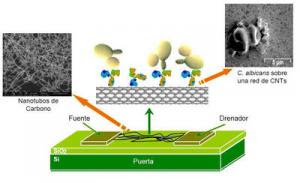
The Nanosensors group from the Universidad Rovira i Virgili has created a biosensor, an electrical and biological device, which is able to selectively detect the Candida albicans yeast in very small quantities of only 50 cfu/ml (colony-forming units per millilitre)."The technique uses field-effect transistors (electronic devices that contain an electrode source and a draining electrode connected to a transducer) based on carbon nanotubes and with Candida albicans-specific antibodies", Raquel A. Villamizar, lead author of the study said.
The Candida samples, which can be obtained from blood, serum or vaginal secretions, are placed directly on the biosensor, where the interaction between antigens and antibodies changes the electric current of the devices. This change is recorded and makes it possible to measure the amount of yeast present in a sample.
"Thanks to the extraordinary charge transference properties of the carbon nanotubes, the fungus detection process is direct, fast, and does not require the use of any marker", remarks Villamizar, who is co-author of a study that provides details of the biosensor and was published recently in the journal Sensors and Actuators B: Chemical.
To date, conventional diagnosis of Candida has been carried out using microbial cultures, serological tests, PCR molecular biology techniques (polymerase chain reactions used to amplify DNA), or immunoassays such as ELISA (Enzyme Linked Inmunoabsorbent Assay).
These techniques require long analysis times and sometimes give rise to false positives and negatives. ELISA also requires the use of markers (compounds that must be added to detect the presence of yeast by fluorescence and other techniques).
The new carbon nanotubes biosensor, however, "makes it possible to improve some of the quality parameters of the traditional methods, for example the speed and simplicity of measurements, and it is an alternative tool that could be used in routine sample analysis", explains Villamizar.
The researcher adds that by using this biosensor "it will be possible in future to obtain a rapid diagnosis of infection with this pathogen, which will help to ensure administration of the correct prophylactic treatments".
The Candida albicans fungus exists naturally in the skin, mouth, the mucous membranes lining the digestive tract, and the respiratory and genitourinary systems. This yeast can cause anything from simple mycosis of the skin to complicated cases of candidiasis. It is much more commonly found in patients suffering from immunodeficiency, tumours, diabetes and lymphomas, among other diseases.
Spiga
INTERNAL MEDICINE The internal medicine blog , where you can have details on alternatice medicine , latest trends in medicine , new drugs in the market , school of medicine etc
Sexually Transmitted Infections: Transistors Used To Detect Fungus Candida Albicans
Monday, May 11, 2009 at 5:39 AM Posted by Sajith
Subscribe to:
Post Comments (Atom)
Search
Labels
- Alzheimer's (10)
- Antibiotics (7)
- Anxiety (1)
- articles (2)
- Bacteria (1)
- behavioral abnormality (1)
- Bio technology (1)
- Brain (8)
- breast cancer (6)
- Cancer (40)
- cancer treatment (7)
- chemotherapy (6)
- Chlamydia (1)
- Cytology (3)
- Death (1)
- Diabetes Mellitus (7)
- Diet (17)
- DNA (1)
- Doctors (1)
- epilepsy (2)
- Fossil (1)
- fruits (1)
- genes (6)
- Genetics (13)
- Geriatrics (1)
- Health (12)
- Heart diseases (9)
- Herbal Medicine (2)
- HIV and AIDS (7)
- influenza (1)
- Inventions (1)
- IVF (1)
- latest findings (1)
- Life style (2)
- Lung Cancer (1)
- Lung Disease (9)
- Microbiology (1)
- Multiple Sclerosis (1)
- Nanotechnology (3)
- Neonatology (1)
- neurology (1)
- News (18)
- Parkinsonism (2)
- Prevention (1)
- Primates (1)
- Prostate cancer (1)
- Prosthetics (1)
- seizure (2)
- Skin (1)
- STD (2)
- Stem cells (9)
- Stroke (1)
- Surgery (2)
- Swine flu (11)
- Virus (1)
- weight loss (1)
Search The Web
Blogger Template by B-Themes | 2008
Minyx v2.0 template es un theme creado por Spiga. | Minyx Blogger Template distributed by eBlog Templates

0 comments:
Post a Comment